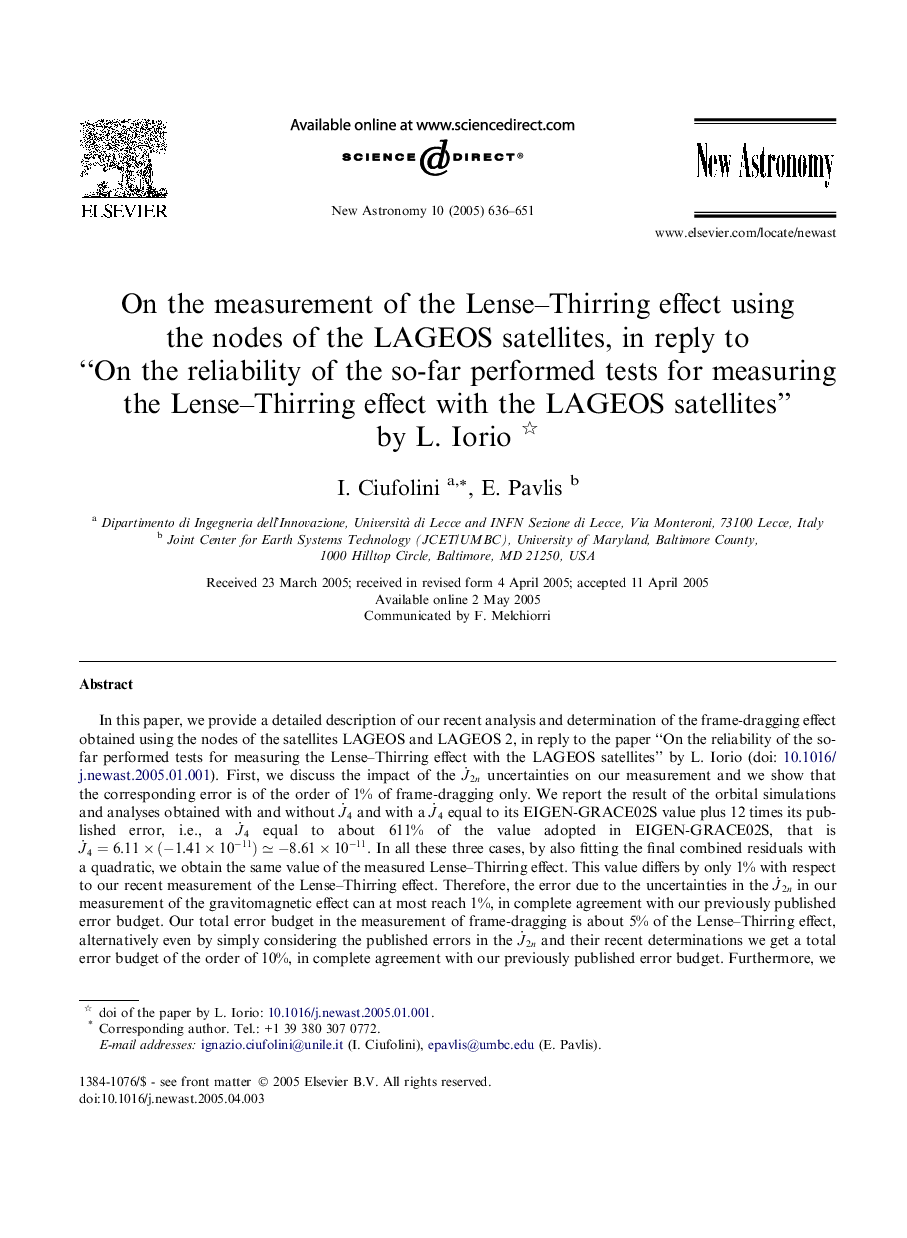| Article ID | Journal | Published Year | Pages | File Type |
|---|---|---|---|---|
| 9827955 | New Astronomy | 2005 | 16 Pages |
Abstract
In this paper, we provide a detailed description of our recent analysis and determination of the frame-dragging effect obtained using the nodes of the satellites LAGEOS and LAGEOS 2, in reply to the paper “On the reliability of the so-far performed tests for measuring the Lense-Thirring effect with the LAGEOS satellites” by L. Iorio (doi: 10.1016/j.newast.2005.01.001). First, we discuss the impact of the JË2n uncertainties on our measurement and we show that the corresponding error is of the order of 1% of frame-dragging only. We report the result of the orbital simulations and analyses obtained with and without JË4 and with a JË4 equal to its EIGEN-GRACE02S value plus 12 times its published error, i.e., a JË4 equal to about 611% of the value adopted in EIGEN-GRACE02S, that is JË4=6.11Ã(-1.41Ã10-11)â-8.61Ã10-11. In all these three cases, by also fitting the final combined residuals with a quadratic, we obtain the same value of the measured Lense-Thirring effect. This value differs by only 1% with respect to our recent measurement of the Lense-Thirring effect. Therefore, the error due to the uncertainties in the JË2n in our measurement of the gravitomagnetic effect can at most reach 1%, in complete agreement with our previously published error budget. Our total error budget in the measurement of frame-dragging is about 5% of the Lense-Thirring effect, alternatively even by simply considering the published errors in the JË2n and their recent determinations we get a total error budget of the order of 10%, in complete agreement with our previously published error budget. Furthermore, we explicitly give the results and plot of a simulation clearly showing that the claim of Iorio's paper that the JË2n uncertainty may contribute to up a 45% error error in our measurement is clearly unsubstantiated. We then present a rigorous proof that any “imprint” or “memory” effect of the Lense-Thirring effect is completely negligible on the even zonal harmonics produced using the GRACE satellites only and used on the orbits of the LAGEOS satellites to measure the frame-dragging effect. In this paper we do not discuss the problem of the correlation of the Earth's even zonal harmonics since it only refers to our previous, 1998, analysis with EGM96 and it will be the subject of a different paper; nevertheless, we stress that in the present analysis with EIGENGRACE02S the total error due to the static Earth gravity field has been calculated by pessimistically summing up the absolute values of the errors due to each Earth's even zonal harmonic uncertainty, i.e., we have not used any covariance matrix to calculate the total error but we have just considered the worst possible contribution of each even zonal harmonic uncertainty to the total error budget. We also present and explain our past work on the technique of measuring the Lense-Thirring effect using the LAGEOS nodes and give its main references. Finally we discuss some other minor points and misunderstandings of the paper by Iorio, including some obvious mistakes contained both in this paper and in some other previous papers of Iorio. In conclusion, the criticisms in Iorio's paper are completely unfounded and misdirected: the uncertainties arising from the possible variations of the JË2n are fully accounted for in the error budget that we have published.
Related Topics
Physical Sciences and Engineering
Physics and Astronomy
Astronomy and Astrophysics
Authors
I. Ciufolini, E. Pavlis,
